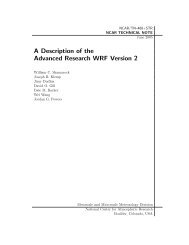You also want an ePaper? Increase the reach of your titles
YUMPU automatically turns print PDFs into web optimized ePapers that Google loves.
<strong>WRF</strong>-VAR<br />
> cp –p $DAT_DIR/rc/2008020512/wrfbdy_d01 ./wrfbdy_d01 (IMPORTANT:<br />
make a copy of wrfbdy_d01 as the wrf_bdy_file will be overwritten<br />
by da_update_bc.exe)<br />
> vi parame.in<br />
&control_param<br />
wrfvar_output_file = './wrfvar_output'<br />
wrf_bdy_file = './wrfbdy_d01'<br />
wrf_input = '$DAT_DIR/rc/2008020512/wrfinput_d01'<br />
cycling = .false. (set to .true. if <strong>WRF</strong>-Var first guess comes<br />
from a previous <strong>WRF</strong> forecast.)<br />
debug = .true.<br />
low_bdy_only = .false.<br />
update_lsm = .false.<br />
/<br />
> ln –sf <strong>WRF</strong>DA/var/da/da_update_bc.exe ./da_update_bc.exe<br />
> ./da_updatebc.exe<br />
At this stage, you should have the files wrfvar_output and wrfbdy_d01 in your <strong>WRF</strong>-<br />
Var working directory. They are the <strong>WRF</strong>-Var updated initial condition and boundary<br />
condition for any subsequent <strong>WRF</strong> model runs. To use, just link a copy of<br />
wrfvar_output and wrfbdy_d01 to wrfinput_d01 and wrfbdy_d01, respectively, in<br />
your <strong>WRF</strong> working directory.<br />
Running gen_be<br />
Starting with <strong>WRF</strong>DA version 3.1, the users have two choices to define the background<br />
error covariance (BE). We call them CV3 and CV5 respectively. Both are applied the<br />
same set of the control variables, stream function, unbalanced potential velocity, unbalanced<br />
temperature, unbalanced surface pressure, and pseudo relative humidity. With<br />
CV3, the control variables are in physical space while with CV5 the control variables are<br />
in eigenvector space. So the major differences between these two kinds of BE are the vertical<br />
covariance. CV3 used the vertical recursive filter to model the vertical covariance<br />
but CV5 used the empirical orthogonal function (EOF) to represent the vertical covariance.<br />
The recursive filters to model the horizontal covariance are also different in these<br />
two BEs. We have not conducted the systematic comparison of the analyses based on<br />
these two BEs. However, CV3 (a BE file provided with our <strong>WRF</strong>-Var system) is a global<br />
BE and can be used for any regional domains while CV5 is a domain-dependent BE,<br />
which should be generated based in the forecasts data from the same domain. At this<br />
moment, it is hard to tell which BE is better; the impact on analysis may be varying case<br />
by case.<br />
CV3 is the NCEP background error covariance, it is estimated in grid space by what has<br />
become known as the NMC method (Parrish and Derber 1992) . The statistics are estimated<br />
with the differences of 24 and 48-hour GFS forecasts with T170 resolution valid at<br />
the same time for 357 cases distributed over a period of one year. Both the amplitudes<br />
and the scales of the background error have to be tuned to represent the forecast error in<br />
the guess fields. The statistics that project multivariate relations among variables are also<br />
derived from the NMC method.<br />
<strong>WRF</strong>-<strong>ARW</strong> V3: User’s <strong>Guide</strong> 6-34

















